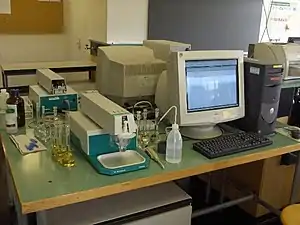
A Polarograph is a chemical analysis instrument used to record automatic voltage-intensity curves.
The Polarograph uses an electrolytic cell consisting of an electrode or microelectrode small area, generally of the mercury drop type, which is a very fine capillary tube through which mercury flows slowly, which comes in the form of small droplets, which fall on the same surface of a much broader element, which is the other electrode . When one applies a variable voltage in this cell, the electrode's large area remains unchanged, while the microelectrode undergoes a change of potential, ( i.e. is polarized). It also has a potentiometer coupled to the motor that moves the recording paper so that a certain voltage variation corresponds to a constant length of recording paper, and a galvanometer suitable for measuring the intensity of the electric current, whose response is transmitted to the actuator that moves the needle of the recorder. The technique used is called polarography.[1] The Czech chemist and Nobel Prize winner Jaroslav Heyrovský invented it.
References
- ↑ «polarògraf».